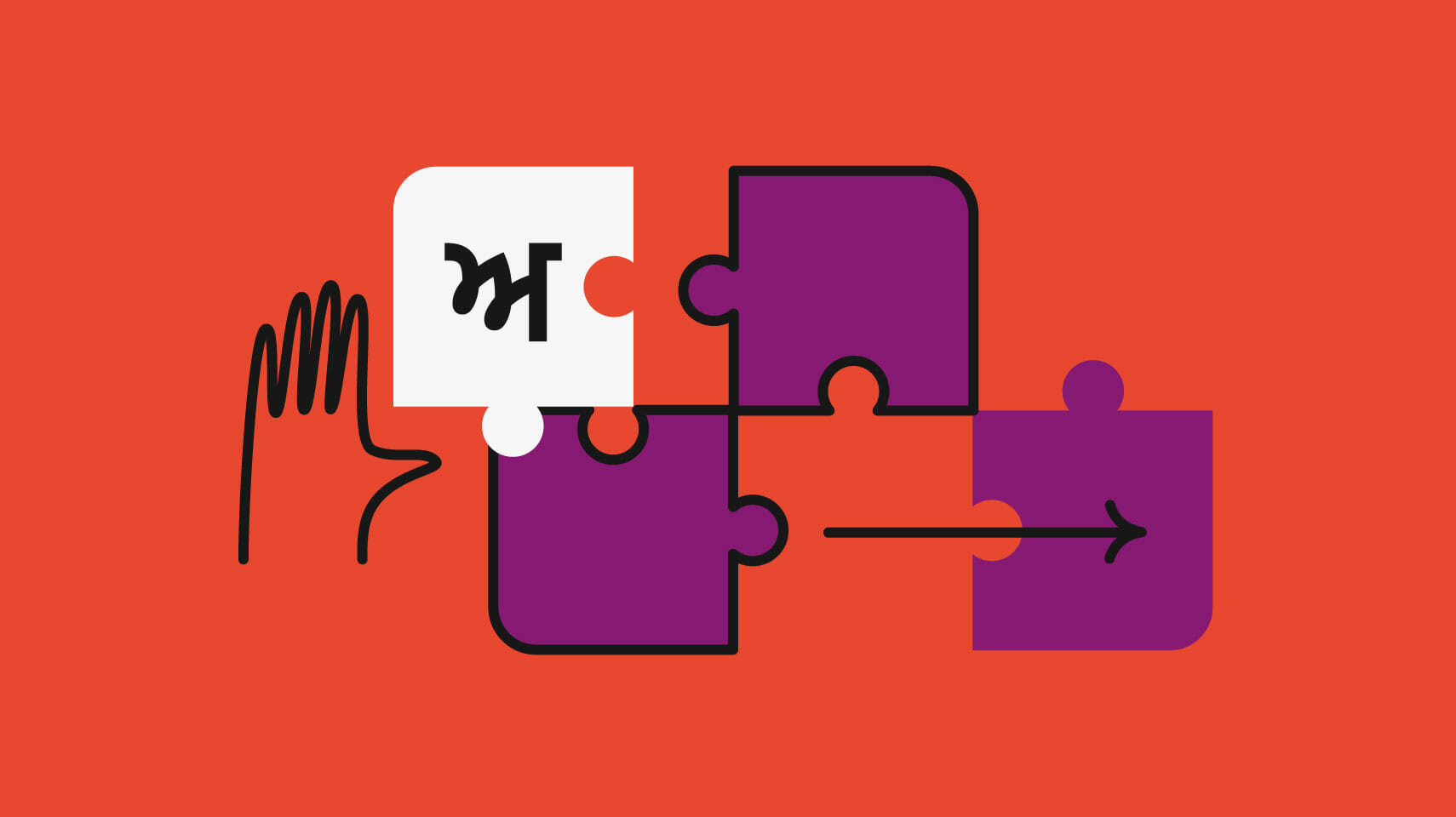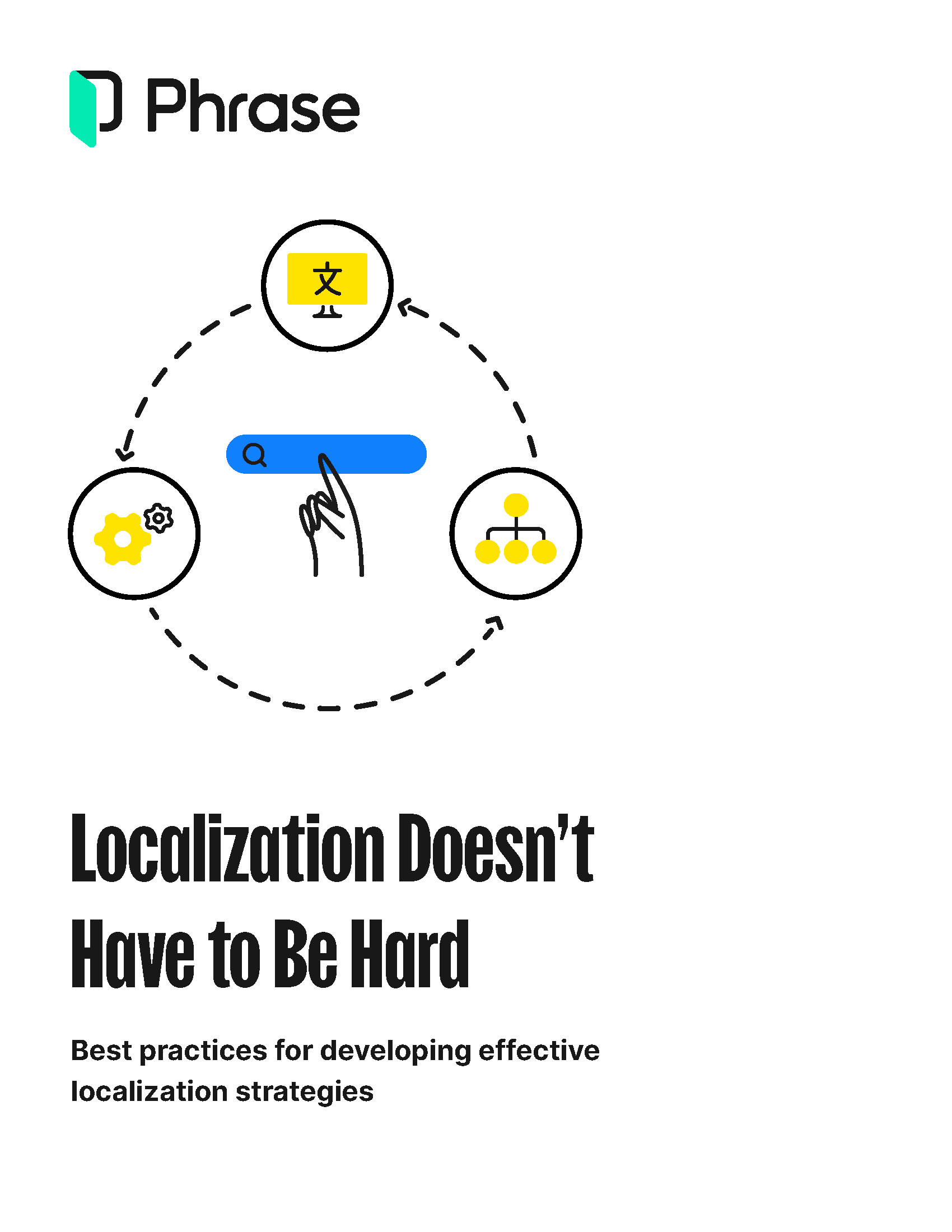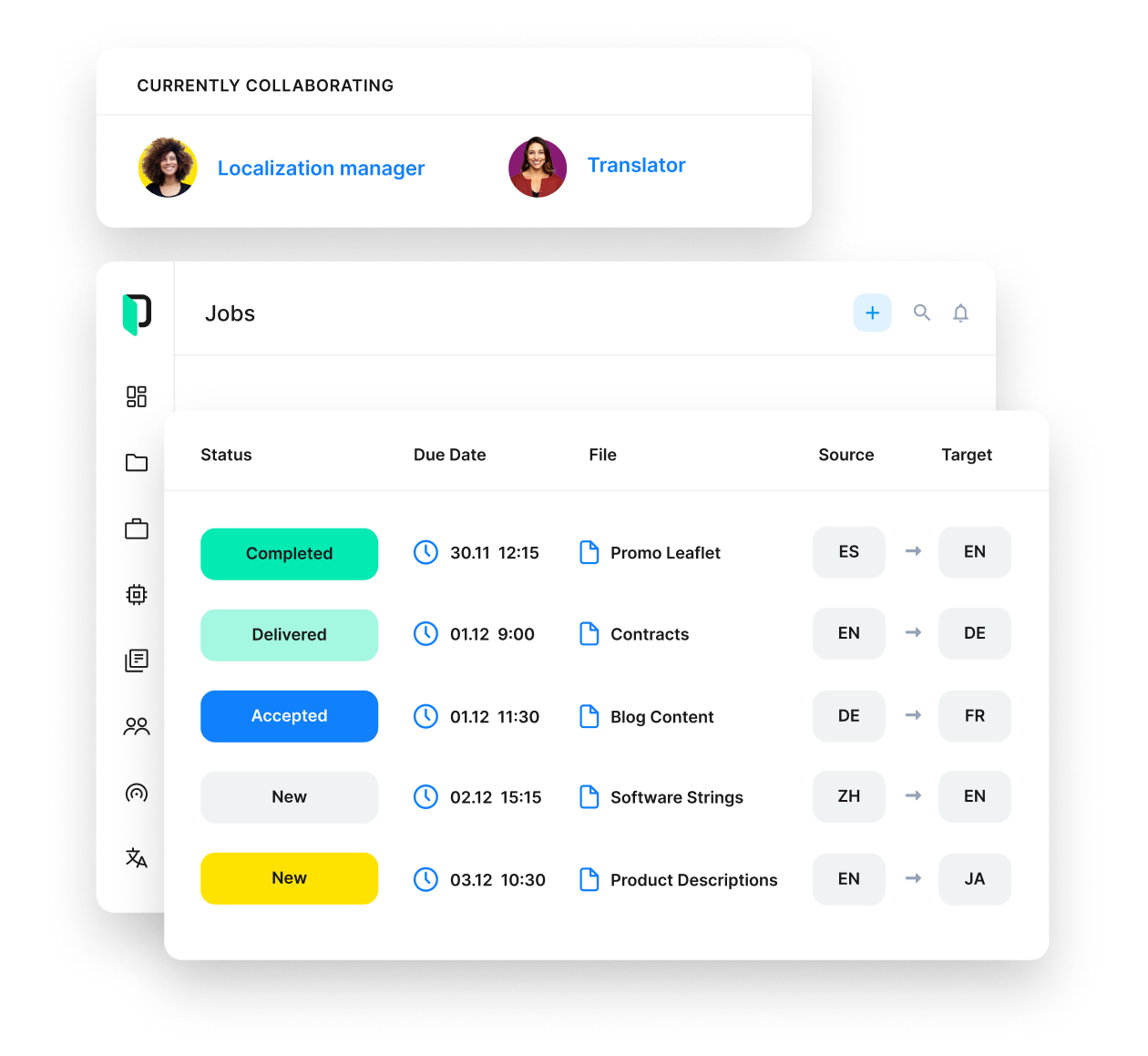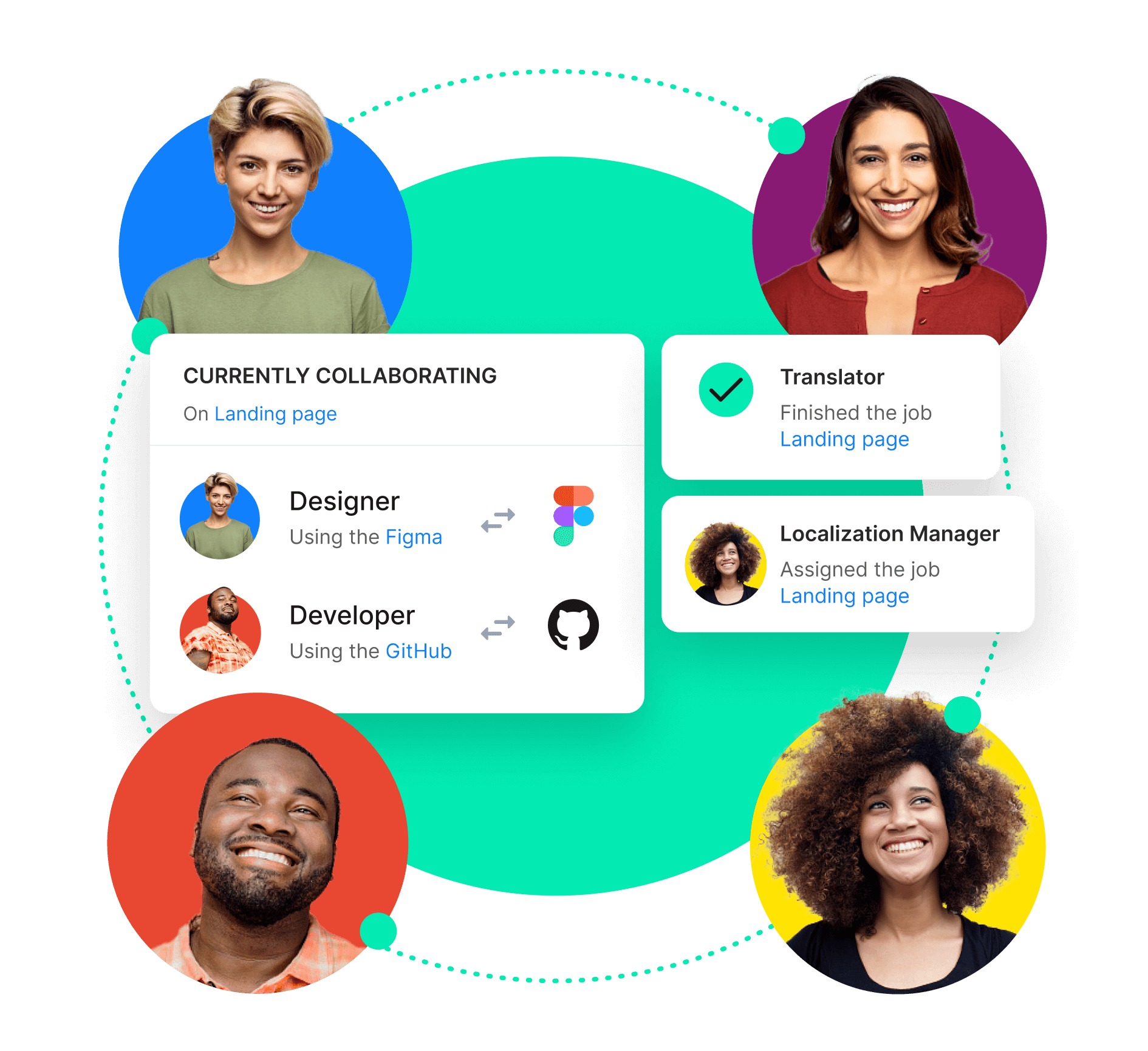Translation management
What Is Translation? A Guide to Transferring Meaning Between Languages

In the continuous quest to generate more leads and boost sales, businesses are looking beyond their domestic market and expanding their products and services to new countries.
Translation is a vital step in this process, and getting it right from the start is critical for the success of any global expansion strategy. After all, if your target audience can’t understand what you’re saying or you’re not conveying the right message, they’re not likely to do business with you.
In this guide, we will explore what translation is, the different types of translation, the challenges and opportunities involved—and how technology can help businesses master the ins and outs of this complex process.
What is translation?
Translation is the process of converting the meaning of a written message (text) from one language to another.
Translators must strike a fine balance between staying true to the original meaning and making a text sound natural in the target language—to ensure that the final text communicates the same message, feeling, and tone as the original.
Translation is an essential tool for businesses looking to globalize their products and services. It helps them break down language barriers and communicate with customers in their native language. It can lead to higher exposure, a larger customer base, and a subsequent boost in sales and revenue. By the same token, bad translation can damage a company’s reputation and lead to costly mistakes.
What are the key approaches to translation?
At a high level, there are two main approaches to translation: human and automatic. Depending on the type of text, the context, the target audience, and other factors, businesses will choose one or the other—or a combination of both. Let’s take a closer look at each approach.
Human translation
Human translation is the conventional approach to translation. In human translation, one or more translators convert the text from the source language to the target language. They may aid themselves with digital tools, such as CAT tools or online resources, but they ultimately rely on their own understanding of the source text, target language, and cultural context to produce an accurate translation.
Human translation is generally more expensive than automatic translation and can take longer to complete, but it offers several advantages:
- First, human translators can capture subtle nuances, such as sarcasm, humor, or double meaning, that machines may struggle to understand. This makes human translation ideal for marketing or other types of texts where these nuances and translation quality are essential.
- Second, human translators specializing in a certain industry or field can bring their domain-specific knowledge to the translation. This is essential for highly technical texts where serious consequences could result from a mistranslation, such as medical or legal documents.
- Third, human translators can accommodate special requests such as staying within a certain character limit—critical for user interface elements or social media posts, for example—or including specific keywords for search engine optimization (SEO) purposes.
- Last, human translators can steer away from literal translations that might sound odd or stilted in the target language and instead opt for a more appealing, natural-sounding translation. This proves especially important for marketing texts where the overall impact is more important than a phrase-for-phrase translation.
Machine translation
Machine translation (MT) involves using software to automatically convert text from the source language to the target language without any human input. Most modern machine translation tools use artificial intelligence (AI) to analyze the source text and generate an automatic translation that retains the original meaning.
- First, it’s much faster than human translation, which makes it ideal for large projects where time is of the essence—for example, ecommerce businesses translating product descriptions en masse.
- Second, it’s more affordable than human translation, which makes it a good option for businesses working with smaller budgets and having to reduce translation costs where content has lower visibility, reach, and ROI.
- Third, machine translation offers automated integration with other software platforms and workflows, making it possible to run entire translation processes without any human involvement. This can be a major advantage for non-brand-oriented content—such as internal documentation—where the goal is simply to make the content accessible to as many people as possible with minimal effort.
Some companies choose a hybrid approach that combines machine translation with human post-editing to get the best of both worlds.
What are common translation techniques or methods?
There are a number of techniques or methods that translators use to convert the source text into the target language. Some are better suited to certain types of text than others, and some may be more appropriate given the client’s needs or the translator’s preferences.
Direct translation techniques
When using a direct translation technique, the translator tries to produce a target text that closely resembles the source text in terms of meaning, style, and structure. This approach is often used for technical or scientific texts where it’s important to retain the original meaning as closely as possible.
Some methods commonly used in direct translation include:
- Borrowing: This involves taking a word or phrase from the source language and using it in the target language text. This is often done when there is no direct equivalent in the target language (at least not yet), or when using the source language term will add precision or clarity. For example, culinary terms such as “tapas” are often borrowed into English.
- Calque or loan translation: This is a type of loanword where the translator literally translates each element of the source text word or phrase and then combines the results to form a new word phrase in the target language. For example, the English term “Adam’s apple” is a calque of the French “pomme d’Adam.”
- Literal translation: This is a type of translation suitable for language pairs that have a high degree of similarity. The translator tries to produce a target text that closely resembles the source text in terms of word order, sentence structure, meaning, and style, with a direct equivalent for each word or phrase. For example, the Portuguese phrase “O gato bebe água” (the cat drinks water) would be translated literally into Spanish as “El gato bebe agua.”
Oblique translation techniques
When using an oblique translation technique, the translator takes a more creative approach, producing a target text that conveys the same meaning as the source text but is not necessarily a direct equivalent. This approach is often used for literary or marketing texts where preserving the original style is more important than retaining the exact meaning.
Some methods commonly used in oblique translation include:
- Transposition: This involves changing the word class of a source text element. For example, a verb in the source text might be transposed into a noun in the target text.
- Modulation: This method changes the point of view in the target text. For example, if the source text describes how something “is difficult”, the translator might decide to render this as “it’s not easy” in the target text.
- Reformulation or equivalence: When idiomatic expressions, proverbs, or culturally specific references don’t lend themselves to literal translation, the translator may use this method to replace them with an expression that conveys a similar meaning in the target culture. For example, the English expression “it’s raining cats and dogs” could become “il pleut des cordes” in French.
- Adaptation or cultural substitution: This is a type of reformulation where the translator replaces a cultural reference in the source text with one that is more familiar to the target audience. For example, if a text mentions a local holiday that is not celebrated in the target culture, the translator might substitute a more widely-recognized holiday. Adaptation is at the heart of the localization vs translation distinction for global products.
What about transcreation?
The term “transcreation” describes a combination of oblique translation methods plus creative writing to produce a target text that is not only culturally appropriate but also engaging and effective in its own right. This approach is often used for marketing or advertising texts where the focus is on creating an emotionally resonant message that speaks to the target audience in their own language.
While transcreation is sometimes seen as a separate discipline from translation, it actually aims to preserve the message, intent, and style of the source text while making it fit for the target audience. This makes it more of a specialty within the field of translation than a separate discipline.
What are some types of translation?
There are several different types of translation, each with its own challenges and best practices. Some of the most common types of translation include:
Business translation
We speak of business translation as an umbrella term when the transfer of meaning between two languages has the purpose of accompanying global business activities. This could involve the most varied types of documents, marketing materials, and digital assets.
Document translation
Document translation is a type of business translation that deals specifically with the translation of business correspondence, internal memos, manuals, legal contracts, technical specifications, and other important documents. Complexity may arise from the large volumes and fragmented nature of business documents, as well as the need to maintain consistent terminology throughout the document corpus.
Legal translation
Another subset of business translation, this specialist area includes the translation of legal, judicial, and juridical documentation. Warrants, registrations, certifications, statements, affidavits, patents, trademarks, proceedings, trials, decrees, contracts, and insurance policies are only some examples of legal documents that may need translating. Accuracy is of the utmost importance in legal translation, as even a small mistake could have major repercussions.
Literary translation
This type of creative translation is all about transferring the meaning, style, and beauty of literary works between languages. From poetry and drama to novels and short stories, literary translation is a true art form that often requires the translator to exercise a great deal of creative freedom to do justice to the source text.
Technical translation
Technical translation groups together a broad range of scientific and technical texts that range from user manuals, service guides, and installation instructions to software strings and datasheets. This type of translation is often complex because of the need to maintain consistent terminology throughout the text, as well as the risk of inaccuracy affecting the safety or efficacy of products or services. Relevant subject matter expertise and the support of terminology management tools are essential for technical translation.
Financial translation
The need for financial services is a global constant, which means that there is a continuous demand for the translation of financial documents. This type of translation may include anything from balance sheets and income statements to auditing reports and market analysis. The emergence of fintech has also created new demand for the translation of software, apps, and websites in this domain.
Ecommerce translation
In the age of global ecommerce, businesses need to be able to reach consumers in multiple markets. This means that landing pages, product descriptions, reviews, and blog posts need to be translated into the language of the target market. Ecommerce translation often needs to strike a balance between accuracy and SEO-friendliness, as well as being adapted to local customs and cultural norms.
Marketing translation
Marketing translation deals with the adaptation of text-based content to make it culturally relevant and linguistically accurate in local markets. At the same time, marketing translation should strike a balance between local relevancy and global brand consistency: While being accurate and true to the original message, it also needs to appeal to local sensibilities.
Medical translation
The medical sector is a highly regulated industry with specific requirements for the translation of clinical trial protocols, patient information leaflets, regulatory documentation, and other important texts. Inaccuracy in medical translation can have life-or-death consequences, which is why this type of translation demands specialist subject matter expertise as well as a high degree of accuracy and attention to detail.
Life science translation
Life sciences is a broad term that covers the fields of medicine, healthcare, pharmaceuticals, and biotechnology. It shares the same purpose as medical translation: Facilitating the dissemination of knowledge and information that can save lives and improve the quality of life of people worldwide. It shares the methodology-related challenges of technical translation, as well as the same high stakes in terms of accuracy and attention to detail.
NGO translation
Translation for NGOs and non-profit organizations often deals with sensitive topics such as human rights, poverty, crisis situations, and disease. The objective of NGO translation is to break down language barriers and facilitate understanding and communication between people of different cultures.
Software translation
Global software products need to be adapted to the customs, conventions, and preferences of the target market. This process is known as software localization, and software translation is part of it—the translation of text strings within the user interface, plus any accompanying documentation. The adaptation of visuals, UX, functionality, and other non-textual elements are other aspects of software localization outside the scope of translation.
App translation
Within software localization, app translation is the process of translating the text content of mobile apps. It usually involves the translation of user interface elements such as buttons, menus, and error messages, as well as in-app content such as product descriptions, help pages, and marketing copy.
Website translation
Website translation is a subset of website localization that concerns itself with translating the textual content of websites into multiple languages—visual or functional elements are not part of the website translation scope. From blog posts and articles to landing pages and product descriptions, website translation helps businesses reach a global audience. Website copy needs accurate, SEO-friendly, engaging, and natural-sounding translation, adapted to the customs and preferences of the target market.

Free download
Best practices for developing effective localization strategies
Explore how to tackle localization management efficiently and engage customers across the globe in their native languages and local experiences.
Translation technology
As technological advances are providing new tools to automate and streamline business processes, the translation function is no exception. From translation apps and plugins to neural machine translation (NMT), translation software is becoming more sophisticated and easier to use, making it a valuable asset for businesses that need to communicate across languages.
Creating an effective translation process, whether you’re working with a team of in-house translators or outsourcing to a translation vendor, is essential to getting the most out of your translation budget. And with the right technology in place, you can streamline your process, save time and money, and get better results.
Let’s take a look at some of the most popular translation software tools on the market today.
CAT tools
CAT (computer-assisted translation) tools are software programs that help translators improve translation quality and work more efficiently by automating repetitive tasks. To evaluate a translation tool and its suitability for your needs, looking at its features and functionality as well as its compatibility with your existing systems is essential.
Most CAT tools offer a number of features that can help with consistency, productivity, and QA, such as:
- Translation memory: It stores previously translated segments of text (called “translation units” or “segments”) in a database. When the translator encounters a new segment that is similar to a stored segment, the CAT tool will offer a translation “match” that the translator can choose to accept or modify. This helps ensure consistency in repeated content and can speed up the translation process by reducing the need to translate the same segment multiple times.
- Term bases or translation glossaries: This feature allows for the creation and management of term bases, which are lists of approved terms and their translations. The translator can consult the term base while working on a translation project to ensure that they are using the correct terminology.
- Quality assurance checks: Automated checks that linguists can run on their translations to identify potential errors. QA checks can catch spelling and grammatical errors, formatting issues, terminological inconsistencies, and more. We will expand on translation quality assessment later in this article.
Translation management systems (TMS)
A translation management system (TMS) is a software platform that helps businesses manage the end-to-end translation process, from project creation and assignment to delivery and review. TMS platforms typically include CAT-tool-like features, as well as additional features for project management, workflow automation, reporting, and more.
The main difference between a CAT tool and a TMS is that a CAT tool is focused on the translation process itself, while a TMS, as the name suggests, is designed to facilitate translation management from start to finish. This makes TMS platforms a valuable asset for businesses coordinating multiple translation projects with different teams or vendors, as the time and effort savings from automation and streamlined communication can be significant.
TMSs can integrate with a variety of other software platforms, such as content management systems (CMS), customer relationship management (CRM) systems, ecommerce platforms, and instant messaging (IM) applications. By using a translation management system, businesses can manage their translations alongside their other business processes, further improving efficiency.

Phrase TMS
The enterprise-ready translation management system
Work with the leading TMS to automate translation workflows with cost control and quality checks.
Translation quality assessment
If you ask any professional translator how to translate documents or how to translate a web page, they’ll likely tell you that one of the most important aspects of the job, regardless of the industry, is ensuring translation quality.
Translation quality assessment is the process of assessing the quality of a translation against specific criteria. Establishing these criteria right from the start is the first step in ensuring that the final translation meets your standards. Once you’ve determined what “good” looks like for your project, the next step is to provide clear and concise instructions and reference materials to the translator (or translation team) to help ensure that they have all of the information they need to produce a high-quality translation.
However, no amount of pre-project planning can completely eliminate the possibility of human error. This is why it’s important to have a translation quality assessment process in place to check translations for errors before they’re published or sent to clients. Depending on the size and complexity of the project, this process can be done manually by proofreaders or linguists, or it can be automated using QA checks.
Common aspects that a translation quality assessment process will cover include:
- Spelling and grammatical mistakes
- Terminology and consistency
- Accurate meaning
- Faithful style
- Fluency and readability
- Layout and formatting
- Culture-specific nuances
- Guideline and brief adherence
Translation services: The link between businesses and the global marketplace
For a product or service to earn trust and respect from customers in different cultures, it needs to be accurate and culturally relevant. The adaptation of products and services for global markets has never been more important—or more complex: The global marketplace is constantly changing, and we live in the era of the customer, where catering to the individual is key to success.
Professional translation services describe the team effort of different experts who help businesses communicate with international audiences effectively. Some of these knowledgeable professionals include:
- Linguists (translators, editors, proofreaders, etc.), who ensure that content reads naturally and appeals to cultural preferences.
- Developers and software localization engineers, who prepare your product at the code level to make it localization-friendly and then integrate the translated content back into the source code.
- UX and UI designers, who create localization-friendly designs, adapt layouts and user interface elements to the specificities of each market and ensure that visuals resonate with the target audience without compromising a consistent look and feel across cultures.
- Localization or translation project managers, who lead the localization process from start to finish for each iteration, centralizing all project-related information and managing communication between all stakeholders.
- Local marketing experts, who help you understand your target market, choose the most relevant channels and platforms for your product or service, and adapt your message to make a lasting impression.
For example, if you’re looking for website translation services, you’ll want to make sure that everyone involved is an expert in their field so that they can best transfer the meaning of your website content between languages.
The role of the translator
Translators play a vital role in the localization process. They are the linguistic experts who transfer meaning from one language to another, considering cultural nuances and preferences. A translator’s job is to produce an accurate and natural-sounding translation that reads as if it were originally written in the target language.
To do this, and to ensure a successful translation career, there’s a series of skills and knowledge that a translator needs:
- In-depth understanding of the source and target languages, including grammar, vocabulary, syntax, idioms, etc.
- Familiarity with the subject matter of the content being translated, and subject matter expertise if translating within a specialized field
- Knowledge of different writing styles and registers, and excellent writing skills in the target language
- Cultural awareness and sensitivity to ensure that the translation is appropriate for the target audience
- Ability to use CAT (computer-assisted translation) tools and other technology
- Exceptional attention to detail
- Commitment to lifelong learning to keep up with changes in language, culture, and technology—for example, by attending conferences, taking courses, and following the best translation blogs and industry publications
A day in the life of a translator can be quite varied. Some translators work as freelancers, while others are employed by translation agencies or in-house localization departments. The type of work can also differ considerably, from translating documents and websites to subtitling videos or interpreting at conferences.
No matter what type of work a translator does, something they all share to ensure success is a passion for language, a will to work collaboratively, an unquenchable curiosity, and an unwavering dedication to quality.
Translation is the springboard to global success
In an ever-globalizing world, the ability to communicate across cultures is more important than ever before. There are dozens of approaches, techniques, and methods for translating content—but at the end of the day, what’s most important is that the meaning is transferred accurately, naturally, and in a way that resonates with the target audience.
Translation isn’t a one-time event, but rather an ongoing process that should be integrated into your overall localization strategy. Technology acts as the great enabler in this process, automating repetitive tasks and facilitating collaboration between all stakeholders.
With the right tools and processes in place, you can streamline your translation workflow, improve the quality of your translations, and get your content to market faster—to take your business to the next level in the global marketplace.

Unlock global business with the Phrase Localization Platform
Expand into new markets with all the tools you need in one technology suite for high-quality, fast, and scalable localization.





